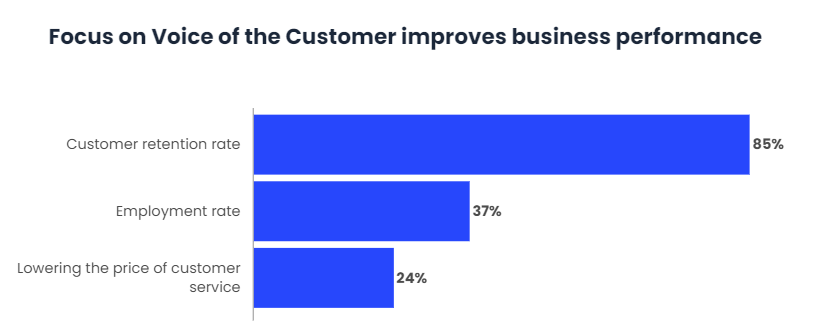That the opinion of users about a company is a fundamental data, is a reality, however, not all companies know how to obtain that information and analyze it to be useful in business development.
More than 80% of companies depend on the quality of the customer experience (CX) they offer to serve as their main competitive strategy. Therefore, listening to the Voice of the Customer (VoC) is quickly becoming an essential action to ensure a successful Customer Experience (CX) program.
The Voice of the Customer
Voice of the Customer (VoC) is a term used in business to describe the in-depth process of capturing customer expectations, preferences and strong dislike. From a pragmatic point of view, VoC refers to the way an organization collects customer feedback, analyzes the data, distributes it to the right people and acts on these ideas to generate financial benefits.
In the days before what became known as Industry 4.0, if a company had a customer who was upset or dissatisfied with its product or service, they would simply complain verbally, and their dissatisfaction would be contained locally and never spread through digital social media. These days, social media makes it easier for customers to share their complaints with a wider audience, which can damage the reputation of the organization’s brand.
That’s why it’s so important to have the technological tools necessary to capture the customer’s voice and all their relevant data, including customer surveys (online/offline), promoter net score, live chatbots, social network channels, online reviews, etc. much more.
While having the desire and budget to measure customer experience is a great start, it is more important to understand what data is really valuable. To realize the value of customer experience metrics and achieve long-term success, proper planning is essential.
- Define what “success” looks like for the company
Each company has different objectives and each product or service is different, so the VoC metrics that are important to each company will be unique. It is important to consult with stakeholders and relevant teams to agree on what the real success is, understanding which metrics are most important to collect, not only today, but a year or two from now.
There are several pre-determined metrics available, including names known as NPS, CSAT and retention rate. Using popular measurement mechanisms such as these offers the advantage of one-to-one comparison because the industry and overall data for these metrics are publicly available. However, the disadvantage is that generic metrics may not adequately capture what is important to measuring the customer experience and preparing for success.
Another option is to define custom metrics specific to each KPI and the product or service. While this makes general industry comparison virtually impossible, these custom metrics allow you to track your own progress internally over time.
There is also a third option. As is often the case, a hybrid approach is a great compromise: create your own benchmarking metrics and add a couple of generic ones as well.
- Compilation and action on comments
Once you have decided what success looks like and what metrics are best for each company, you should agree on how to collect the relevant information for the KPIs and metrics you have chosen.
The choice of approaches will depend on the type of information you wish to collect. NPS, for example, is the information that customers provide during an interaction with the brand. Depending on the point of contact, the information can be collected through an online survey, a pop-up or a customer service representative. The final step is to decide which tool to use to capture all this information.
It’s not always easy to find the magic formula when it comes to successful Voice of the Customer programs. Variations exist for B2B and B2C organizations, across specific industries, and even across regions. But the best VoC programs in their class have some elements in common:
- Customer insights are not only collected, but shared in the right way with the right stakeholders at the right time to drive change.
- These are usually multi-channel programs that offer customers the right channel to share their feedback.
- They combine structured feedback (through surveys, for example) and unstructured feedback (social networking, email complaints, etc.) to provide a holistic view of the customer experience.
- Have a customer-centric culture that leverages knowledge to drive change at all levels of the organization to drive business results.
How to get the data for the metrics?
Understanding loyalty and gathering feedback at key points along the customer journey has helped many organizations become industry leaders in their field, using a variety of tools:
Companies today have the option of using online survey tools to collect data from a large group of people from different demographics, with different requirements and expectations. However, if they simply create surveys and implement them randomly, they cannot guarantee how useful the data collected will be. You will get a lot of data to work with, but if you want to get smart, actionable information, then you need to be strategic about implementing surveys.
In parallel there are the types of surveys that can be implemented online: NPS, CSAT, CES, etc., each of them has its own strengths and you can get valuable direct feedback.
Some online survey software platforms also have voice survey functionality, which allows you to open a window to what the customer is really thinking. Experienced researchers can adapt and modify surveys on the fly, gaining better insight into the process.
These two options are just one example of all the options available. However, in order to collect the right feedback at the right time, each company must ensure that it is collected in the channel in which their customers want to participate. Not only will this increase response rates, but it will show customers that the company cares about their preferences as well.
A combination of the main channels is ideal (all integrated into one solution):
- Web
- Email
- Mobile (SMS, application)
- Phone
- Social Media
No one channel is better than another: it’s about selecting the right way to interact with users so that they want to share their comments and know how to act.
What benefits will companies get?
Voice of Customer programs have been shown to help organizations retain customers, create better products, deliver better services and systematically understand the customer experience to drive change. Organizations that understand the journey of their customers are much more likely to improve their products to meet the changing requirements of their customers and thereby foster customer loyalty.

Putting the focus on the Voice of the Customer will give every organization new insights and offer great results, as long as you take action on the knowledge you receive:
- Increased revenue: through reduced turnover, better cross-selling opportunities and the ability to attract new customers.
- Reduce costs: by improving processes, ensuring compliance and creating greater process consistency.
- Promoting cultural change: by driving customer centralization and cross-functional change.
How important can Artificial Intelligence be?
So far we have seen how companies should define metric standards and which tools will be the best to obtain those metrics, however, where innovation really lies is in the use of Artificial Intelligence.
Voice of Customer driven AI is the perfect combination between AI services and a business application. It creates a solution that provides data analysis on feelings, products, customers and citizens, leveraging natural language processing and advanced text analysis.
Like other methods, AI-driven VoC increases revenue and improves the customer experience by using information based on data analysis, but these systems go one step further:
- Better understanding and perception of public opinion and the brand.
- More responsible and truthful information.
- Machine Learning, helps to link ideas that will build a better consumer experience in the future.
- Better understanding of the perception of the product and how it coincides with the wishes and needs of the customer.
Conclusions
Voice of Customer can be extremely valuable if used effectively. It is important for companies to remember that collecting data just for the sake of collecting it will only serve to frustrate customers and maintain their static experiences.
Metrics are the most valuable way to measure customer experience over time. When time and effort is spent defining the right metrics and planning the measurement strategy, putting VoC data into action can have a positive impact on a company’s bottom line.
In addition, the emergence of AI in this area can offer great additional benefits. AI-driven VoC uses concept extraction, sentiment analysis and other advanced natural language processing to truly understand what customers are saying in social networks and surveys.





















